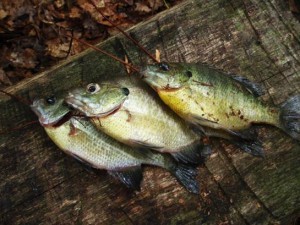Fish can be caught all year long in most environments; the key is to understand the fish you are going after and what will most likely provoke it to strike.
After that, if you find yourself in a survival situation, being able to use your surroundings to your advantage to maximize your chances at catching fish is just as important.
When & Where To Go Fishing
If it is hot and the water is low the fish will seek out deep, shaded waters. When it is cold you would rather find them in more shallow areas where the sun has a better chance at warming the water. Fish love those spots that are “special” in some way. Like where the bank/shore protrudes over the water, trees that hang out over the water, rocks, submerged trees/stumps/boats/cars/etc.
If you are fishing in a stream/river fish tend to be found in the slower flowing waters like the outer edge of a bend or where a smaller stream meets a larger stream, etc.
Some signs of a perfect fishing spot is when the fish are jumping out of the water or when ripples are clearly visible on the surface of the water. These are generally signs that the fish are currently feeding. Also if you see a bunch of small fish darting about it is probable that there is a larger predatory fish in the vicinity.
It is generally not very productive to fish after a heavy rain fall.Hooks
The one thing great about improvising hooks is they can be made out of almost any material, including but not limited to needles, safety pins, nails, paper clips, thorns, a bird wishbone or claw, a piece of metal cut from a can, soda tab and even a piece of carved wood.
A simpler type of hook — the gorge or toggle hook — has been used by primitive people for centuries. This is a short (1 inch or less), straight piece of hard material, such as bone, antler or wood that has been sharpened at both ends and slightly notched in the middle where it’s attached to the line. The gorge is hidden inside a piece of soft bait, and when a fish swallows the bait, the fisherman pulls the line and the gorge turns (hopefully!) sideways, lodging it in the fishes throat.
Lures
You can make lures from pieces of cloth, feathers, an earring or bits of bright metal fashioned to imitate natural food like a minnow or insect. In many waters, all you need to catch fish is a strip of colored cloth attached to a hook.
Trotlines
During a survival or emergency situation your time is valuable. So why not maximize that by using Trotlines?
When fishing using trotlines or traps it is generally most productive to leave them out over night and check them just before first light.To build a trotline you would weight one end of a line to the bottom of the body of water. At interval lengths, along the line, tie on shorter strands of line each with a baited hook. The end of the line, that is opposite the weighted end, you can either place a float/buoy or tie it off to something on shore like a stake or a branch of a tree.
Check the line periodically throughout the day to see if any fish have been caught. While checking the line, one can also replace bait, untangle drop lines, and retrieve any fish on the line.
Like any survival skill, the best way to get really proficient at fishing is to practice it a lot.
Make sure you actively fish, however; you want to think like a fish and then place your lure, bait or trot line where you feel pretty sure you are likely to be successful.
To learn more about survival fishing techniques, please visit Emergency Outdoors.
